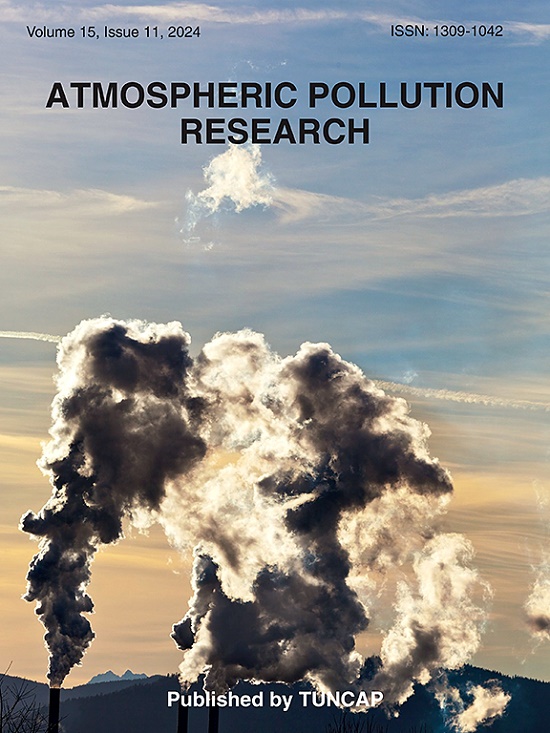Emission characteristics of volatile organic compounds from industrial and stationary combustion sources in the Ili River Valley core area, China
IF 3.9
3区 环境科学与生态学
Q2 ENVIRONMENTAL SCIENCES
引用次数: 0
Abstract
One hundred and fifteen types of volatile organic compounds (VOCs), mass concentrations, composition profiles, and emission factors (EFs) for industrial processes and stationary combustion sources in the core area of the Ili River Valley were investigated using the GC-MS analytical method. This is of great significance for VOC emissions in northwest China. The results show that benzene (25.5%), ethylene (20.8%), 2-butanone (11.3%) and tetrahydrofuran (10.2%) were the most abundant species in the coal-based synthetic natural gas (SNG) industry. Oxygenated VOCs (OVOCs) were the most important chemical group in the pharmaceutical manufacturing (PM) and the manufacture of other condiments and fermented products (MOCFP). Acetaldehyde, acetone and 2-butanone are the tracers for these two industries. Acetylene and vinyl chloride accounted for 84.3% of the weighted share of emissions from polyvinyl chloride synthetic resin (SYR). M/p-xylene, 1,2,4-trimethylbenzene, toluene, acetylene, and o-xylene accounted for 31.7% of the total VOC species in stationary combustion. Two SNG plants have the highest VOC emissions with 2804.5 and 559.8 t/a respectively. PM is the second largest VOCs emitting industry (218.5 t/a), with acetone being the most abundant species. The EF of PM was the largest (13.54 g/kg product), and the EFs of SNG, SYR, and MOCFP were 0.48, 0.145, and 0.45 g/kg product, respectively. The VOC EF of stationary combustion was the lowest (2.12E-05 g/kg coal). However, the average source reactivity (SR) was highest for stationary combustion and SNG. OVOCs, aromatics and alkenes were the main VOC groups to be prioritised for ozone pollution control.
伊犁河谷核心区工业和固定燃烧源挥发性有机物排放特征
采用气相色谱-质谱分析方法,对伊犁河流域核心区工业过程和固定燃烧源的115种挥发性有机化合物(VOCs)、质量浓度、成分分布和排放因子(EFs)进行了研究。这对西北地区VOC排放具有重要意义。结果表明,煤基合成天然气(SNG)工业中苯(25.5%)、乙烯(20.8%)、2-丁酮(11.3%)和四氢呋喃(10.2%)是最丰富的物质。含氧VOCs (OVOCs)是制药(PM)和其他调味品和发酵产品(MOCFP)生产中最重要的化学类群。乙醛、丙酮和2-丁酮是这两个行业的示踪剂。乙炔和氯乙烯占聚氯乙烯合成树脂(SYR)加权排放量的84.3%。M/对二甲苯、1,2,4-三甲苯、甲苯、乙炔和邻二甲苯占固定燃烧VOC总量的31.7%。两家制煤厂VOC排放量最高,分别为2804.5和559.8 t/a。PM是第二大VOCs排放行业(218.5 t/a),其中丙酮是最丰富的种类。PM的efe最大(13.54 g/kg), SNG、SYR和MOCFP的efe分别为0.48、0.145和0.45 g/kg。静止燃烧的VOC EF最低,为2.12E-05 g/kg煤。而固定燃烧和制煤的平均源反应性(SR)最高。vocs、芳烃和烯烃是臭氧污染控制的主要挥发性有机化合物。
本文章由计算机程序翻译,如有差异,请以英文原文为准。
求助全文
约1分钟内获得全文
求助全文
来源期刊

Atmospheric Pollution Research
ENVIRONMENTAL SCIENCES-
CiteScore
8.30
自引率
6.70%
发文量
256
审稿时长
36 days
期刊介绍:
Atmospheric Pollution Research (APR) is an international journal designed for the publication of articles on air pollution. Papers should present novel experimental results, theory and modeling of air pollution on local, regional, or global scales. Areas covered are research on inorganic, organic, and persistent organic air pollutants, air quality monitoring, air quality management, atmospheric dispersion and transport, air-surface (soil, water, and vegetation) exchange of pollutants, dry and wet deposition, indoor air quality, exposure assessment, health effects, satellite measurements, natural emissions, atmospheric chemistry, greenhouse gases, and effects on climate change.
 求助内容:
求助内容: 应助结果提醒方式:
应助结果提醒方式:


